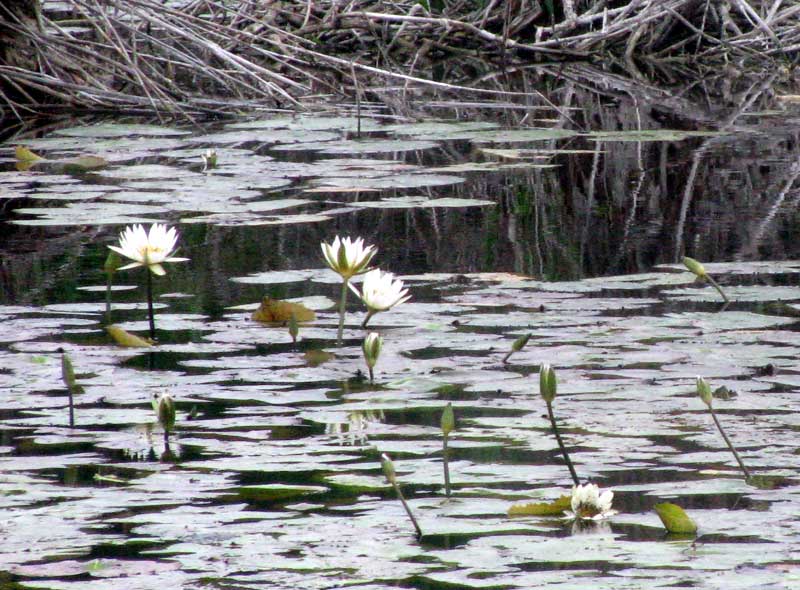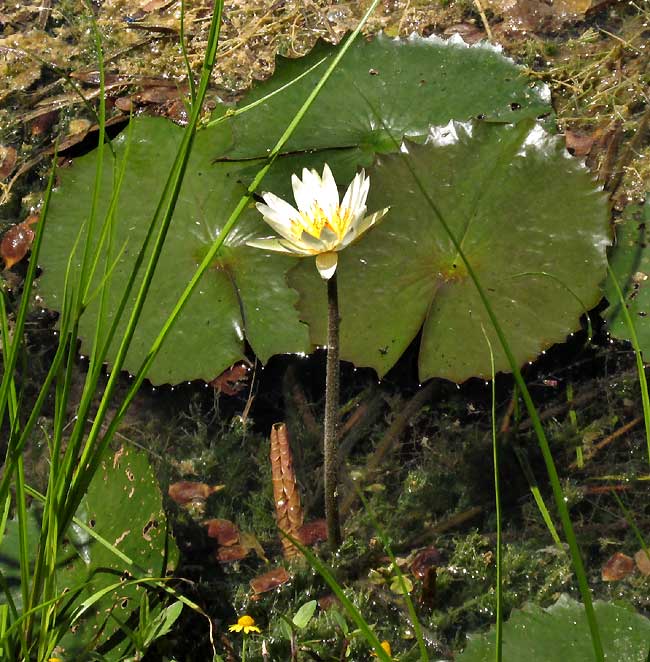Excerpts from Jim Conrad's
Naturalist Newsletter

from the October 30, 2011 Newsletter issued from Mayan Beach Garden Inn 20 kms north of Mahahual; Caribbean coastal beach and mangroves, ~N18.89°, ~W87.64°, Quintana Roo state, MÉXICO
WATERLILIES FLOWERING
While crocodile watching this week I got the nice picture of the Dotleaf Waterlily shown above with those distinctive black dots on the undersides of the greenish sepals:

from the July 10, 2011 Newsletter issued from Mayan Beach Garden Inn 20 kms north of Mahahual; Caribbean coastal beach and mangroves, ~N18.89°, ~W87.64°, Quintana Roo state, MÉXICO
SACRED MAYA FLOWER
During a bike ride last Sunday the road brought me close to several ponds and lakes. Among the most eye-catching plants at one of the ponds was the white-flowered waterlily shown above. In that picture, the leafless tangle in the background consists of branching aerial roots of the Red Mangrove. The open water is completely surrounded by Red Mangrove, which apparently finds the water lilies' water a little too deep.
I couldn't get close enough to the lilies for a good picture but a couple of flowers floated near enough to reveal field marks enabling their identification. Notice the crinkled leaf margins and -- barely visible -- lines of tiny black spots on the flowers' greenish sepals below:

In the literature English names given for this species include Dotleaf Waterlily, White Water Lily and White Lotus. It's NYMPHAEA AMPLA.
And that interested me greatly, for back in the 1970s for a couple of dry seasons I served as naturalist for the Foundation for Latin American Anthropological Research, FLAAR, based in Guatemala City, Guatemala. We specialized in taking tourists with special interest in Maya archeology to very hard-to-reach Maya ruins deep in the rainforest of northern Guatemala and Chiapas, Mexico, and on those trips we always were on the lookout for water lilies.
That's because the archeologist leading the tours had theories about ancient Maya shamanistic use of water lily flowers. And the water lily in question was our Nymphaea ampla. If you Google the keywords "sacred Maya flower" the first return should be a PDF document published by my former boss, Nicholas Hellmuth, entitled Sacred Maya Flower.
In that document you can see how Maya iconography apparently represents Nymphaea ampla in various religious contexts, the water lily occupying the zone between the Maya netherworld, under the water, and the world of humans beyond the water. Sometimes the water lily motif sprouts from the head of people portrayed in Maya art, maybe even with a fish in mid-air nibbling on the water lily. This, maybe, represents a shaman in contact with the spirit world, through the agency of the water lily, which may be mildly hallucinogenic.
Whatever the deal, last Sunday it was good to see lots of Nymphaea ampla in a little pond nearby. The species is very sensitive to environmental changes, having disappeared in many areas where the water became stirred up or polluted.
Nymphaea ampla is found from Texas south through Mexico, the West Indies and Central America into South America.
from the October 19, 2018 Newsletter with notes from a camping trip into northern Guatemala's Petén region
WHITE WATERLILY IN GUATEMALA
A couple of weeks ago, on October 1, I checked into the campground of El Rosario National Park adjacent to Sayaxché, in Guatemala's lowland northern department of the Petén. The campground overlooks a pretty little lake, and here and there along the lake's margin waterlilies were flowering. You can see one below

Good fieldmarks for this species are the low, broad "teeth" along the floating leaves' margins, and the flower's white, slender petals. I think the white splotches along the leaves' margins are precipitated calcite, because the bedrock there is limestone and the water was very limy. A close-up of the blossom is shown below:

At first I thought the black specks dotting the inside faces of the blossom's petal-like calyx lobes was dirt. However, then I recalled that in 2011 we met this species in mangrove swamps along the Caribbean coast of the southern Yucatan Peninsula, near Mahahual. At that time {see above} we saw that one name given for the species, besides White Waterlily, is Dotleaf Waterlily. The "dirt" on the blossom is those dots extending onto the calyx.
Back then I mentioned that in the 1970s I'd worked with an archaeologist interested in the White Waterlily's role in Maya art and spirituality. Nowadays more information on the matter is available, as you can see on Entheology.Com's White Water Lily page.
There it's noted that in ancient Maya iconography the rain god Theotihuacan often was depicted with water lily leaves, buds and flowers, usually held in his mouth. A Mayan hieroglyph known as the "Jaguar Water Lily glyph" apparently represents a transformed shaman whose transcendent state was aided by the use of White Waterlily flowers. Apparently the flowers are somewhat hallucinogenic, and in recent times have been used by some recreationally.